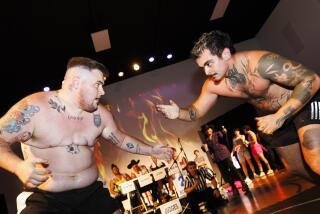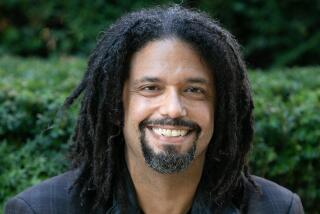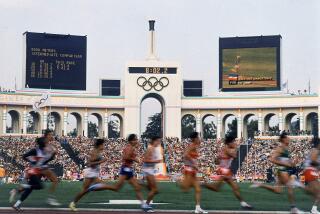ENTERTAINMENT REVIEW : Wrestling With Reality at Arena : A seven-act drama filled with big sweaty men in tights doing violent things unfolds on the new Anaheim stage, and it isnât pretty.
ANAHEIM â Youâve got to hand it to people in this county: Give them a chance to expand their cultural horizons, and they fling themselves at the opportunity.
Just as folks flocked to the Performing Arts Center to enjoy stale musicals in a coffee-free environment, they similarly have taken to the offerings of the new Anaheim Arena.
The 19,400-seat multipurpose hall was more than more than half-filled Monday night, a remarkable turnout considering the esoteric, but decidedly American, drama-dance event taking place there.
Itâs sweaty, half-naked men in tights; itâs professional wrestling.
Though it owes a nod to some of the oldest dramatic forms, particularly the Sanskrit Mrcchakitika with its heavily stylized gestures and costumery, the World Wrestling Federation program that unfolded on a square stage at the center of the arena exhibited a repertoire of movement and meaning thatâs as wholly American as the red, white and blue ropes ringing the stage.
The drama was presented in seven acts, linked not by common characters, but by repetition of thematic movement and the barest rubric of plot.
The players all entered the stage via a long barricaded path running through the audience, so similar to a slaughterhouse cattle run that it created the immediate impression of something that would be both blood ritual and calculatedly corporate. The proceedings didnât disappoint.
Thereâs a lot of action to impart here, so excuse us if we rush through it:
Act One: Terrific Terry Taylor enters in black robe with silver stars and crimson appointments, followed by the 1-2-3 Kid wearing a lightning-bolt design and looking like a bottle of Jolt Cola with arms.
The Kid appears friendly. Taylor refuses to shake hands. Heâs a poor sport and the audience, whose participation is crucial to the proceedings, reviles him.
The pair, in an elaborate, muscular ballet, grapple with the old good-evil dualism, as the Three Stooges might have, were there not three of them.
*
In this and the following acts there is another player onstage: Justice, in the form of a referee. He is nearly a ghost image, powerless and often oblivious to the action, seemingly not noticing when one participant is trying to unscrew the otherâs head or slam his face into the metal steps outside the ring. It is left to the audience to absorb this outrage.
Act Two: Papa Shango, a black man, enters to ominous music. Heâs carrying a burning skull, his face is painted as a skull and heâs garbed as a voodoo king--not that wrestling deals in broad, insulting racial stereotypes or anything. He and his dance partner move in slow motion, as insects battling in molasses.
Like the grinding battle scenes of Orson Wellesâ âChimes at Midnight,â itâs certainly a metaphor for the exhausting futility of war.
Act Three: Samu and Fatu, two gentlemen of a Samoan cast, enter, waving their wild dreadlocks, flicking their tongues at the audience, kicking up hula-skirt leggings. They are called the Head Shrinkers--not that wrestling deals in broad racial stereotypes or anything. They are so wild and uncivilized that they konk each other on the head.
Enter the Smoking Gunns--Bart Gunn and Billy Gunn--in full long-coated Western regalia, including six-guns, which they pull out and begin to blast in the direction of the Head Shrinkers, who, like good natives everywhere, cower in a corner, fearful of the white manâs fire sticks. Not that wrestling deals in. . . . Manifest destiny!
The Gunns, naturally, are good guys, and they preen and pose like theyâre the next Billy Ray Cyruses, which they probably are. The theme of the failure of justice crops up again: As the ref wags a finger at one cowboy, behind him his partner is being slowly strangled with a rope.
Seemingly a goner, the one Gunn is bounced off the ropes by the Heads, who are prepared to deck him on the rebound. Instead he floors them, where they roll around like pill bugs. The ref declares the Shrunken Heads winners, though the mayhem continues after the bell peals.
*
Act Four: Giant Gonzalez, a tall 460 pounds of love in an Alley Oop caveman bodysuit, and the lank-haired Ozzy Osbourne clone known as the Undertaker (328 pounds) wrestle with weighty concerns.
Another convention of the form is introduced: One dancer is pinned by the other, seemingly paralyzed in an inescapable grip. After long frozen moments, the ref lifts one of the pinned dancerâs arms to see if heâs still among the living.
He does this once, twice, and the arm falls lifeless. On the third try, there is a quiver. The arm rises defiantly, and the whole body begins to shake, sloughing off the opponent. The same scenario is repeated two more times in the following acts.
Gonzalezâs manager, a Mr. Peepers in a purple Joker suit, enters and is whacked by the Undertaker, who is in turn hit with a chair by Gonzalez.
Before intermission, we are introduced to Bam Bam Bigelow, a mean large person, who states his desire to scalp his opponent, a purported American Indian named Tatanka.
During the intermission fans purchase official programs ($5 for 36 flimsy pages, 20 of them ads), plastic champ belts ($14), T-shirts ($20) or red sponge-foam Tatanka tomahawks ($5).
Act Five: The moccasined, red-Mohawked Tatanka enters the ring waving a somewhat more substantial tomahawk, lighting out after Bigelow, who soon turns the tables and deposits his 360 pounds on Tatankaâs chest, prompting a child near me to gleefully remark, âMan, he squished him!â
Pinned, Tatanka does that whole quivering arm bit. As the foam tomahawks wave flaccidly all over the arena, he tears free and begins a frenetic war dance, echoed mockingly by Bigelow, after squishing him to the floor again.
The maddened Indian sends him sailing out of the ring in a graceful arc. The referee, responding to his own inner turmoil, disqualifies both, though this only prompts an attempt by Bigelow to scalp Tatanka, who produces his tomahawk and chases Bigelow out of the arena.
*
Act Six: The Narcissist Lex Luger primps before a full-length mirror in his corner, rippling his pecs. Razor Ramon, good guy, runs afoul of him, gets knocked to the floor and is given petulant little slaps by Luger.
The ref gets whacked to the floor, a popular place in this act. Ramon helps him up, slapping him a few times for fun. Luger slams Ramon from behind, and the ref unjustly counts Ramon out with a fast count. Fans, a veritable geek chorus, shout furiously at the ref.
Act Seven: Enter Mr. Perfect. Enough said.
Enter Shawn Michaels, bad guy, wearing chaps. History: At a previous event, Michaels snuck up on Perfect backstage and hit him with a trash can. That context means all, as Perfect, out to humiliate, tugs Michaelsâ pants down, exposing his bare butt to the whole wrestling world.
Michaels is aided by a looming manager, though, who lashes out at Perfect. The ref is oblivious to this and other perfidies, and adjudges Michaels the winner. Wrong prevails, leaving the audience begging for a sequel, which we are given to understand will take place in an inescapable 16-foot cage at a future World Wrestling Federation event.
*
This is some weird, funny stuff, essentially a comic book fleshed out. It also is popular: If theyâd only done a tag-team âHamlet,â the GroveShakespeare theater company would probably still be in business.
It also is pretty darn disquieting, in that much of the audience Monday clearly didnât regard the wrestling as anything but real sport.
With the same glassy stares of people who have been hoping too long in Vegas, many in the arena seemed willing to put aside the obvious in order to believe in something.
Throughout the evening there wasnât one punch thrown that wasnât pulled, not one rope-a-dope routine that wasnât clearly choreographed, not one sneak attack that wasnât given away by thousands of screaming voices.
Yet it wasnât just the many children in the crowd that groaned with each fake contact or yelled with blood lust. Adults paid good money to shout, jeer and contort their faces in anger at the refâs calls.
The most disturbing thing were the calls coming from the wheelchair section near me: âLetâs see some blood!â âCripple him!â and, when Tatanka was on, âSend him back to the reservation!â That willingness to invest so much of themselves in a convenient and evidently cathartic lie is scary stuff. Scarier still is the wrestling matchesâ consistent theme that law and reason--represented by the referees--is feeble and of no recourse, and that only power prevails.
*
Not to sound overly paranoid, but if one wanted to steer a nation toward fascism, thatâs just the sort of message youâd promote. Thatâs a frequent theme in films, books and other entertainments, but itâs particularly eerie here, because for so many the event is real.
Maybe professional wrestling is becoming our national sport, in influence if not in numbers. In the last national election, people were polled as rejecting some candidates not because of their abilities or beliefs, but because they didnât look presidential .
*
Rock music, once the province of honesty and emotion, has become a parade ground for formula-bound performers who put more effort into their grimaces than they do their solos.
Image is everything, says one current fashion designerâs ad.
Wrestling is just big fun, dopey stuff, if you can ignore the blatant racism and anti-democratic themes. But if you ever wake up one day and hear the radio announcing something from Washington about President Giant Gonzalez, remember you read it here first.
More to Read
The biggest entertainment stories
Get our big stories about Hollywood, film, television, music, arts, culture and more right in your inbox as soon as they publish.
You may occasionally receive promotional content from the Los Angeles Times.










